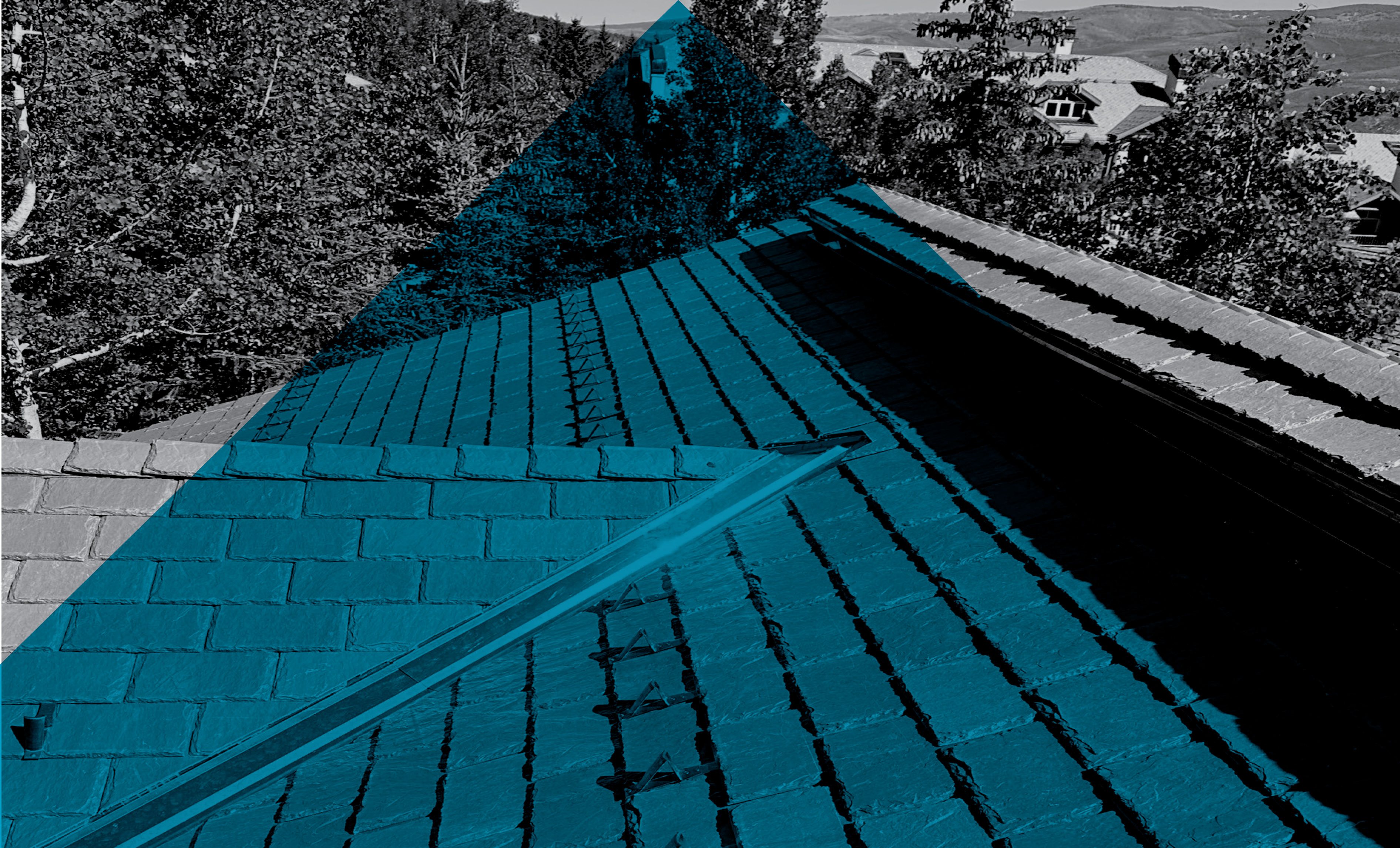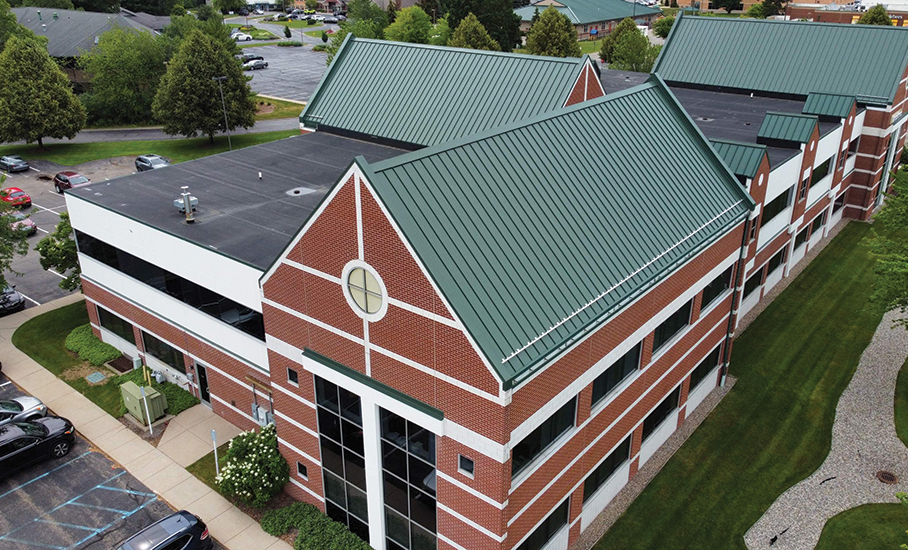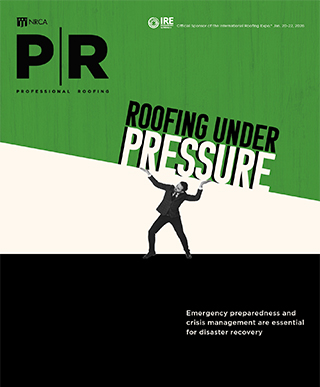
This past March, the roofing industry shined a spotlight on a specific area of roof safety. For the first time, National Snow Guards Safety Month made it a priority to focus on education and safety related to the installation of snow-retention systems. The focus on these systems can help save lives and prevent property damage.
From snow guards to fences and bars, snow-retention systems are installed on roofing projects throughout the U.S. Especially useful on “slick” roof surfaces such as metal, slate, synthetics and tile, they also are mounted on concrete and asphalt roof systems, as well as in conjunction with solar panels. Without them, roofs can be dangerous after heavy snowfalls.
Protecting property
As contractors understand, customers often don’t know what is in their best interest. And they don’t always listen either, which can result in problematic situations.
Scott Kim, president of WGM Contracting, Fairfax, Va., recently dealt with one such client. After advising and educating the homeowner about why a snow-retention system should be installed on their home, the homeowner denied the recommendation. Then winter came. Along with it came a chunk of built-up snow that slid off the main roof onto the home’s glass sunroom’s roof, nearly breaking the glass.
“The homeowner saw the impact of what happened and came back to us,” Kim says.
Kim told the homeowner their synthetic slate roof could be slippery when snow builds up.
“We ended up doing a retrofit application of galvanized snow guards and staggered them 12 inches on center top and bottom. This solved the problem immediately,” he says.
Snow bondage
What makes snow so “slippery” on certain roofs that it has the potential to cause dangerous slides?
When snow falls on a roof, two bonds are formed. The first is an adhesive bond between the snow and the roofing material. It’s easy to visualize this type of bond in other areas. Think of a wind-blown snowstorm when you see snow stuck to a stop sign. The stop sign is vertical, yet the snow is stuck to it. That’s an adhesive bond at work.
The second type of bond is a cohesive bond. It’s the connection between molecules of the same substance. Imagine a snowball. As you pack snow together, the pressure causes some snowflakes to melt, creating a tiny film of water between them. The water refreezes and forms ice that binds the other snowflakes together, creating a cohesive snowball. The snowball is stronger packed together than the individual flakes would be separately.
Both these bonds form when snow falls on a roof. When the sun is out, even if it’s behind clouds, it can warm roof surfaces. Because clouds and snow are translucent (meaning the sun’s energy will penetrate through both), a layer of water can form on the roof surface below the snowpack.
This layer of water on the roofing material breaks the adhesive bond from the roof. At this point, the only thing keeping snow on the roof is the cohesive bond. Once the cohesive bond breaks, the entire snowpack can release in one slide. And snow is surprisingly heavy. The weight of 1 square foot of snow at a depth of 1 foot can range from about 3 pounds for light, dry snow to 21 pounds for wet, heavy snow. Multiply that by 200 square feet of roof surface, and you can see how quickly the weight adds up. This is what makes snow on roofs so dangerous.
However, a snow-retention system is designed to keep a snowpack stable, so when the bonds break, the snow will stay put until it turns into meltwater and safely leaves the roof through the gutters.
Selling snow guards
Although snow-retention systems are designed for safety, they are not always understood by or appreciated by homeowners. People resist adding them to their roofs for a variety of reasons. Some do not wish to mar the appearance of their roofs with snow-retention systems; others believe they don’t have a need for a snow-retention system.
In Littleton, Colo., most of the projects worked on by On Point Contracting require snow-retention systems.
“One of our clients originally refused repairs to a pipe boot and adding a snow-retention system on his home,” says Nick Piontek, founder of On Point Contracting. “He was initially shocked at the cost of the system and decided not to move forward. I kept following up to understand his reservations better. It turned out that though price was a factor his main concern was the snow-retention pieces would make his roof look unattractive.”
According to Piontek, this is a challenging perception to change, but he comes across it often.
“Our client had invested in high-end slate tiles and didn’t want anything to damage the aesthetics of the home exterior,” Piontek says. “However, after showing him photos of completed projects with snow guards and explaining their vital purpose, the homeowner relented.”
After repairing the pipe boot and installing the snow guards in a soldier row pattern, the homeowner was pleased.
“He actually liked the modern touch the snow guards add to the house,” Piontek says. “He even left us a 5-star Google Business review on our listing because he was so happy with how the project turned out.”

New versus existing roofs
Contractors should note there are differing approaches to snow guard installation that depend on whether installation will take place on a new or existing roof.
When installed at the same time as a roof system, snow guard fasteners can be “buried” under the courses above. A retrofit installation will have exposed fasteners. This is one of the biggest motivators for a roofing contractor to get customers to have snow guards installed at the time of roof system installation.
Some other things to consider are the size of the snow guard product being used and whether a nonpenetrating attachment can be used.
A longer snow guard (for example one that is 16 inches) would be used as part of a new roof system installation. However, a shorter (5- or 10-inch) snow guard would be used in a retrofit option. The longer length allows the piece to be fastened far above the course line, and the shorter guards allow for installation without removing the roofing tile.
Some roof systems, such as standing-seam metal, could benefit from snow guard installation that does not penetrate the roof surface. Some options include clamps or brackets.
Safety tips
Whether installing roofing materials or snow-retention systems, nothing is as important as safety. Because of this, Rocky Mountain Snow Guards, a distributor of various snow-retention systems based in Englewood, Colo., developed some safety tips for roofing contractors as part of National Snow Guards Safety Month:
- Make sure the roof surface is snow-, water- and frost-free. Wet roofs are slippery. This also means snow-retention systems should not be installed during or immediately following a snowstorm. Roofing workers should not work on snowy, frosty or wet roofs. If required to work at heights, regardless of the conditions, workers must be protected from falling with proper fall-protection systems.
- Always tie off ladders at eaves and make sure the bases of ladders are secure. Ladders should be positioned high enough above the eave to allow enough space (NRCA suggests at least 3 feet) to get on and off as safely as possible.
- Follow all standard roof safety procedures. Don’t take shortcuts. Workers must be protected from falling with the use of fall-protection systems, including guardrails or personal fall-arrest systems.
- Mark the locations for snow guard placement on roofs before installation. This can speed up the installation, keep workers focused and eliminate a sloppy placement appearance.
- Snow guards often are required to be installed within 3 feet of eaves. Depending on the property, it may be safer to work off a ladder or lift versus being on the roof for the installation. NRCA notes that snow guards in unheated overhanging portions of a roof can aid in the formation of ice dams. The lowest row of snow guards should be kept upslope of a vertical line drawn 1 foot inside the heated wall. Snow on roofs below snow guards can shear off, so the benefits of snow retention compared with ice dam limitation should be considered when determining the location of the lowest row of snow guards especially where large overhangs exist.
- Always follow the snow guard manufacturer’s suggested layout. Many roofing contractors assume they know the best pattern for snow guards. However, often what they know is different than the tested and proven layouts manufacturers recommend.
- When fastening a snow fence into a truss system, it is crucial to pre-drill to avoid splitting the truss.
- Snow-retention products should never be used as anchor points for a fall-protection system.
- Always team workers up so you have an installer and a handler. This way, a snow guard gets passed on safely and doesn’t fly off the roof, potentially causing a dangerous falling-object situation.
Simplifying snow
Snow can complicate any number of roofing-related issues, but snow guards can prevent or reduce those complications and any resulting damage snow can cause. Educating customers about the benefits of snow guards can be an important part of your relationship building.

BRIAN CROSS
Production and marketing manager
Rocky Mountain Snow Guards


